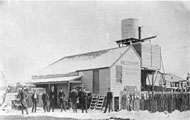Water use in Milllthorpe and District Homes
Millthorpe Freezing Works
The Crosley 'Icyball' was widely used during the 1920s. One ball was heated over a fire and the other ball became cold and was placed in a refrigerator cabinet. This kept food cool for about 24 hours. By the 1930s, the Hallstrom Model A Refrigerator had perfected the cooling process with a device similar to the icyball. The cold ball was hidden from view in a wooden chest. A kerosene flame heated the finned unit.
By the 1940s the refrigerators became upright and burned kerosene to provide the heat for the cooling compartment. The introduction of electricity and the modern refrigerator and freezers completely changed Millthorpe households.
The Bathroom
In the early homes there were no bathrooms. Children were bathed in round zinc tubs in front of the open fire where water had been heated from the hanging buckets in the kitchen fireplace.
Water was often scarce in rural households and weekly baths would take place in a tin bath in the laundry and shared by more than one family member. Bedrooms contained Jug and Basin sets on washstands for the early morning or evening wash.
Today
Water is still a valuable resource, but its methods of use and collection have changed in our homes. Millthorpe residents use council supplied water from Lake Rowlands, while many rural households still use large water storage tanks or wells. However, many of our homes use more water than is necessary, while the emphasis is still on conservation.
